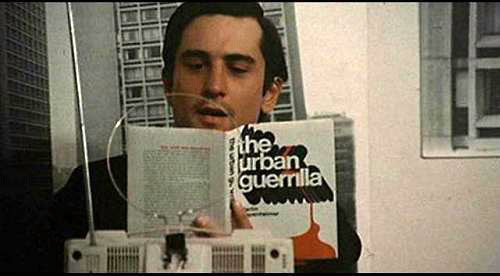Hi, Mom!
1970's HI, MOM! is the second of director Brian De Palma's late '60s wry counter cultural satires, though this time the tone has darkened, a choice congruent with the shifting times. Where the previous GREETINGS maintained a caustic but generally lighthearted tone, HI, MOM! quite willingly will employ elements of murder and even rape to make its damning points about racial, political, and social ills. Today's viewers unable to contextualize may have a tough time wading through parts of this troubling movie. It was a very different era.
Robert De Niro returns as wannabe filmmaker Jon Rubin, again involved with fast talking pornographer Joe Banner (Allen Garfield), who hires the Vietnam vet to shoot a nudie. After agreeing to rent an apartment in nightmarish disrepair from a slumlord (Charles Durning, credited onscreen as Charles Durham) in an uproarious opening scene, Jon sets up his tripod to capture the bourgeoisie in the high rise across the way. Each window features viable subjects for a potential 8 mm quickie: a group of female roommates, a guy and a girl who like to role play, another guy and girl who paint themselves black, and even a typical American family.
Jon notices that one of the roommates is always left home alone. He decides he likes her. Judy (Jennifer Salt) may prove more than just a good celluloid subject. They go out on a date, telling lengthy sad tales of their previous relationships. Some of the conversations are quite funny, the humor paving the way for many of the fictional neurotics seen in later sitcoms and feature films. John decides to film their consummation. It does not go as planned.
Meanwhile, we learn the guy with the paint (Gerit Graham) is an actor in what used to be called "experimental theater". The current production is called "Be Black, Baby!" Its highly unfortunate (white) attendees, pretentious types who seek an immersive experience, are treated to humiliation and all manner of abuse. They are painted in blackface by the cast (who are in whiteface), forced to eat soul food, and led through stairwells where the actors become increasingly hostile. Confrontational theater in the name of teaching the privileged Caucasians what its like/how it feels to be black.
De Palma had worked in this arena of theater and his filming of the events feels frighteningly real. The sequence, which occurs a little past the mid way point of the movie, has a certain power I've rarely experienced while watching a film. It comes off as being entirely improvised, a guerilla cinema verite shot in grainy black and white with a handheld camera where anything can happen. I was angered, saddened, repelled, and utterly fascinated. Manipulated? De Palma wants you to squirm, perhaps realize his art house film viewers are no better than his onscreen targets. Aside from the last moments of the "Be Black, Baby!" sequence - when the battered audience raves about the show - I did not find it funny, though some viewers may look at it in a larger, more abstract manner and be able to extract the humor.
The rest of HI, MOM! has a mix of angry social commentary - The "Be Black" crew do "man on the street" interviews that turn hostile - and more conventional, though no less observant, humor - Jon has a lengthy conversation with a pharmacist about prophylactics. De Palma, co-writing with producer Charles Hirsch, hit all of their targets and often effectively use whimsy to underscore their points. The film is successful, right up to the final scene in which a T.V. reporter asks Jon to comment on a recent bombing, but still leaves a bad taste. I got the message, but at times I wanted to muzzle the messenger.



Comments